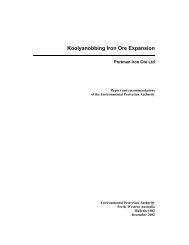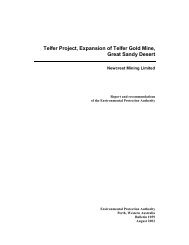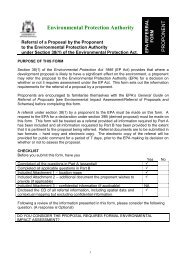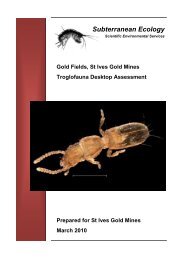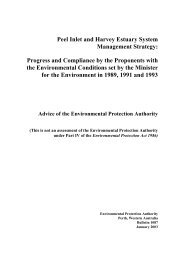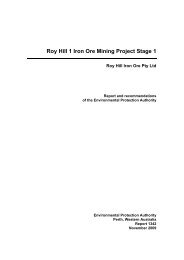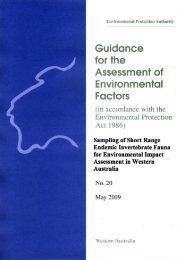Flora survey for Hamersley Drive recreation - Environmental ...
Flora survey for Hamersley Drive recreation - Environmental ...
Flora survey for Hamersley Drive recreation - Environmental ...
Create successful ePaper yourself
Turn your PDF publications into a flip-book with our unique Google optimized e-Paper software.
FRNP Improvement Project: Culham Inlet to <strong>Hamersley</strong> Inlet GF Craig– July 2010<br />
2. Methods<br />
The botanical <strong>survey</strong>s were carried out by Gillian Craig, except <strong>for</strong> the Declared Rare eucalypts on East<br />
Mt Barren which were <strong>survey</strong>ed independently by Ellen Hickman (Craig and Hickman 2009). The results<br />
of those <strong>survey</strong>s have been included here to provide complete documentation of the flora between<br />
<strong>Hamersley</strong> Inlet and Culham Inlet.<br />
Desktop<br />
A search was made of the Department of Environment and Conservation’s (DEC) Threatened <strong>Flora</strong><br />
Database (DEFL), WA Herbarium database (WAHerb) and the Declared Rare and Priority <strong>Flora</strong> Species<br />
List. The search co-ordinates requested were NW corner: 33 o 45'S 119 o 45'E SE corner: 33 o 57'<br />
120 o 14'E. A search was undertaken of the DEC Threatened Ecological Communities database.<br />
The Commonwealth’s Threatened <strong>Flora</strong> database was searched to determine the category under the<br />
<strong>Environmental</strong> Protection and Biodiversity Conservation Act (EPBC Act) <strong>for</strong> listed Threatened flora.<br />
The flora database in<strong>for</strong>mation was imported into OziExplorer® software to determine those species<br />
likely to occur in the impact area. Digital orthophotos of the Whoogerup (2003- pre-burn) and<br />
Ravensthorpe (2007 – post-burn) map sheets were provided by DEC to use as base imagery.<br />
Scientific licences and a Regulation 4 Authority permit were obtained from DEC to take flora within the<br />
Fitzgerald River National Park. Permission to use digital in<strong>for</strong>mation was obtained from DEC’s Species<br />
and Community Branch, Kensington.<br />
Previous reports and publications relevant to the region were reviewed.<br />
K.R. Newbey relevés<br />
During 1985 and 1986, the late Ken Newbey recorded plant taxa in 309 relevés in the park with<br />
permanent quadrats marked at 65 of these sites <strong>for</strong> fauna sampling (Chapman and Newbey 1987). The<br />
plant species data from all Newbey’s relevés within and immediately adjacent to the study area were<br />
databased using the Perth herbarium’s MAX V3 software. Since 1987 there has been considerable<br />
revision of the taxonomy, there<strong>for</strong>e the author updated Newbey’s species names to current taxonomy<br />
and changed species names to those which are known from the area, e.g. Isopogon attenuatus became<br />
I. polycephalus, and I. buxifolius became Isopogon sp. Fitzgerald River. This in<strong>for</strong>mation was used to<br />
provide an initial species list <strong>for</strong> the area.<br />
Eucalypts on East Mt Barren<br />
DEC Albany’s threatened flora files <strong>for</strong> Eucalyptus coronata and Eucalyptus burdettiana were reviewed<br />
by Ellen Hickman, specific locations of all known population on and around East Mt Barren were<br />
identified and plant numbers were summarised to get an overview of each species.<br />
Orthophotos from the Ravensthorpe sheet (2003 – pre-burn and 2007 – post-burn) were provided by<br />
DEC <strong>for</strong> use in the field.<br />
Field <strong>survey</strong><br />
<strong>Hamersley</strong> <strong>Drive</strong>, spur roads and carparks<br />
The <strong>survey</strong> was carried out according to the <strong>Environmental</strong> Protection Authority’s Draft Guidance No.51<br />
(EPA 2004). Each side of the road, new alignments and proposed walk paths identified by DEC were<br />
traversed on foot, between the verge and up to 25 m into the undisturbed vegetation. Along each<br />
traverse, boundaries of vegetation units (based on changes in species composition) and threatened flora<br />
were marked as waypoints on the GPS using the GDA94 datum.<br />
3



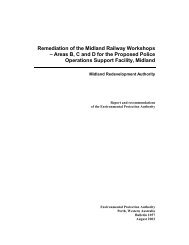
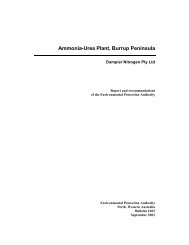
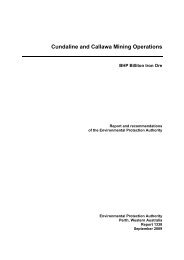
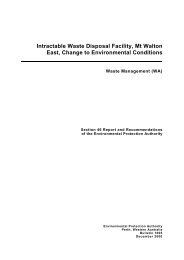
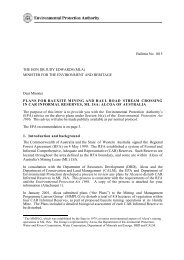
![[Project Title] - Environmental Protection Authority - The Western ...](https://img.yumpu.com/29001740/1/184x260/project-title-environmental-protection-authority-the-western-.jpg?quality=85)
